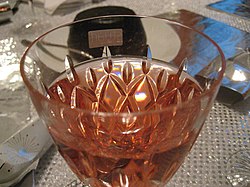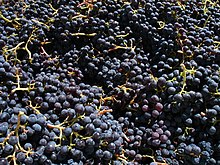Grenache
| Grenache | |
|---|---|
Rioja | |
| VIVC number | 4461 |

Grenache (
It is generally spicy, berry-flavored and soft on the palate and produces wine with a relatively high
In Spain, there are monovarietal wines made of Garnacha tinta (red Grenache), notably in the southern
History

Grenache or Garnacha (as it is known in Spain) most likely originated in the region of
Grenache was one of the first varieties to be introduced to
Viticulture

The Grenache vine is characterized by its strong wood
Grenache prefers hot, dry soils that are well drained but it is relatively adaptable to all
Mutants and crosses
Over centuries, the Grenache vine has produced
Winemaking

Grenache is often used as a blending component, adding
The high levels of
Wine regions
Grenache is one of the most widely planted red wine grape varieties in the world with France and Spain being its largest principal wine regions. In the late 20th century, total acreage of Grenache in Spain has been on the decline with the vineyards being uprooted in lieu of the more fashionable
France

In France, Grenache is most widely associated with the wines of the Rhône and southern France. Its history in the Rhône can be traced to the influence of
The grape's thin skin and pale coloring makes it well-suited for the production of full bodied, fruit
Spain
In Spain, Grenache is known as Garnacha (Garnatxa in
Garnacha plays a major role in the
Aragon
Aragon, believed to be the probable origin of the grape, concentrates the largest surface of Grenache (or Garnacha as it is called locally) in Spain, with 40,034 acres (16,201 ha) planted. Garnacha is the dominant variety in the region and is typically used to produce single variety wines. Even though in the mid-20th century Garnacha was considered a "workhorse" variety for large volume wines, in the last 20 years a new generation of winemakers have taken a new approach, by controlling yields, taking advantage of the old vines (from 30 to more than 100 years), and applying modern techniques in combination with old traditions to increase concentration. The
Rioja
In Rioja the grape is planted mostly in the warmer Rioja Baja region located in the eastern expanse of the wine region. Usually blended with Tempranillo, Garnacha provides juicy fruitiness and added body. In recent years, modern Rioja producers have been increasing the amount of Garnacha used in the blend in order to produce earlier maturing and more approachable Riojas in their youth. Garnacha is also used in the pale colored
Compared to neighboring Rioja, the Garnacha-based blends of Navarre are lighter and fruitier, meant for earlier consumption.[6]

Priorat
Ampelographers believe Garnacha has had a presence in the
Italy
Grenache is most commonly found as Cannonau in the island of Sardinia where it is one of the principal grapes in the isle's deeply colored, full bodied red wines that routinely maintain alcohol levels around 15%. The Sardinian D.O.C. wine Cannonau di Sardegna is by law at least 90% local Grenache (Cannonau).
Grenache is also found in the regions of
Other Old World regions
Grenache has been grown in
Australia

A clone from
United States

In the early California wine industry, Grenache's high yields and alcohol level made it an ideal blending component for jug wine production. Early plantings centered in the hot central San Joaquin Valley, where the grape benefitted from its tolerance to heat and drought. It was first used to produce sweet, pale colored "white Grenache" wines similar in quality and substance to
South Africa
Grenache Noir came to the Cape in the 19th century but was only confirmed as such in the early 1900s by a Stellenbosch University professor. While there isn't a lot of Grenache Noir planted in South Africa at only 305 hectares in 2014, many of the 100+ Grenache based blends are proving to be very fashionable with winemakers due to South Africa's warm climate, dry land and granitic soils.[12]
Other New World wine regions
Despite being one of the world's most widely planted red grape varieties, Grenache's colonization of the New World has been limited apart from strongholds in Australia and California. The rising popularity and success of the Rhone Ranger's movement has brought greater attention to the variety and more plantings of Grenache are popping up every year in places like
Wines


Though Grenache is most often encountered in blended wines (such as the Rhone wines or
The characteristic notes of Grenache are berry fruit such as
Synonyms
Grenache is known under a variety of synonyms across the globe. These include: Abundante, Aleante, Aleantedi Rivalto, Aleante Poggiarelli, Alicant Blau, Alicante, Alicante Grenache, Aragones, Bois Jaune, Bordò, Cannonaddu, Cannonadu Nieddu, Cannonau, Cannonau Selvaggio, Canonazo, Carignane rosso, Elegante, Francese, Gamay del Trasimeno, Gamay Perugino, Garnaccho negro, Garnacha Comun, Garnacha negra, Garnacha Roja, Garnacha tinta, Garnatxa negra, Garnatxa Pais, Gironet, Granaccia, Granaxa, Grenache noir, Grenache rouge, Kek Grenache, Lladoner, Mencida, Navaro, Navarre, Navarre de la Dordogne, Navarro, Negru Calvese, Ranconnat, Red Grenache, Redondal, Retagliadu Nieddu, Rivesaltes, Roussillon Tinto, Roussillon, Rouvaillard, Sans Pareil, Santa Maria de Alcantara, Tentillo, Tintella, Tintilla, Tinto Menudo, Tinto Navalcarnero, Tai rosso, Toledana, Uva di Spagna,[13] and Vernatxa.[14]
See also
References
- ^ ISBN 87-567-7140-1.
- ISBN 9781905819157.
- ^ ISBN 978-0-1986-0990-2.
- ^ a b Radden, Rosemary. "Grapes and Wines of the World". The State Library of South Australia, GPO Box 419, Adelaide SA 5001. Archived from the original on August 7, 2007. Retrieved May 5, 2007.
- ^ "È il vino sardo il più antico del mondo, prove di una specie di Cannonau di quasi tremila anni fa". December 10, 2016.
- ^ ISBN 978-0-1560-3291-9.
- ^ ISBN 978-05-2-026138-9.
- ^ a b c Robinson, Jancis. "Garnacha Peluda". Wine Grapes p. 403, New York: HarperCollins, 2012.
- ^ Alley, Lynn (September 30, 2007). "New French Wine Grape Arrives in US Market". The Wine Spectator.
- ISBN 978-1-56305-434-1.
- ^ Entry in DRAE
- ^ "Higgo Jacobs' Top 20 South African Grenache Noirs". Explore Sideways. June 27, 2017. Retrieved July 19, 2017.
- ^ Maul, E.; Eibach, R. (1999). "Vitis International Variety Catalogue". Information and Coordination Centre for Biological Diversity (IBV) of the Federal Agency for Agriculture and Food (BLE), Deichmanns Aue 29, 53179 Bonn, Germany. Archived from the original on April 11, 2007. Retrieved May 5, 2007.
- . Retrieved January 4, 2020.
